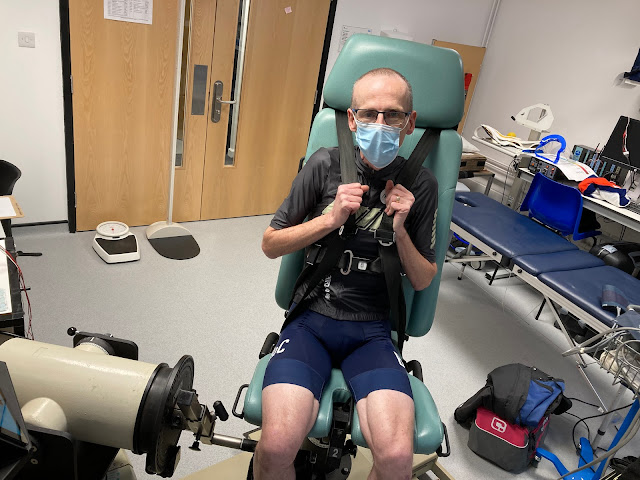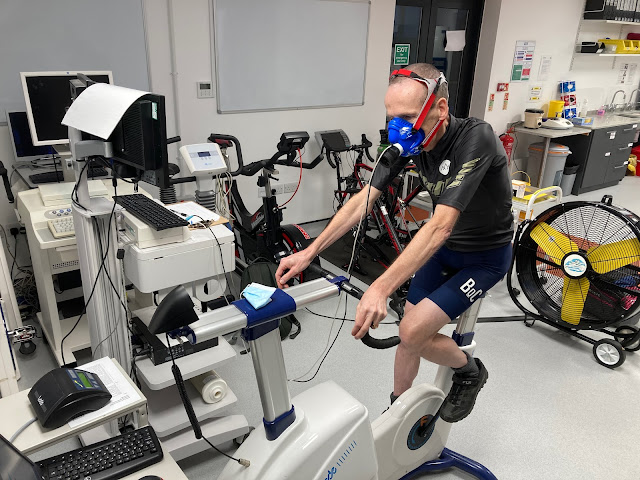At the end of last year I was sent some info on a health study being run at Kent University.
It was to study the effects of ageing on Physiologic complexity, mitochondrial capacity, and muscle function.
A little explanation; I didn't know what it meant.
Physiologic complexity, mitochondrial capacity, and muscle function are important physiological measures to our understanding of the aging process. Aging has been shown to result in a loss of physiologic complexity, mitochondrial capacity, and muscle function. This diminution in physiological functioning, potentially underlies frailty and a reduced health span with age. There is, however, promising evidence that exercise may provide an effective intervention for maintaining and/or restoring the functioning of these key physiological measures with age. The PhD aims to explore the effect of physical activity levels and aging on human skeletal muscle function and adaptability.
The first of three visits to the lab was on the 8th Jan.
It included a session on a device that measures my functional threshold power or FTO. It is the average number of watts that a rider can sustain in an hour, and acts as a current measure of fitness. I was completely shattered at the end of the test; which is how the test ends. The bike steadily increases the resistance until you can't pedal anymore. The face mask allows the measurement of VO2 max, or maximal oxygen consumption. That is the maximum amount of oxygen that an individual can utilize during intense or maximal exercise. This measurement is generally considered the best indicator of cardiovascular fitness and aerobic endurance.
What is physiological complexity?Outputs of physiological processes (such as muscle contractions) measured over a time-series produce complex fluctuations in their signals, which appear self-similar over multiple measurement scales. The ‘complexity’ of these signals can be measured, with a ‘complex’ signal producing irregular self-similar fluctuations. Whereas a less ‘complex’ signal produces more regular fluctuations and may have a narrower frequency. Physiological signals have been shown to become less complex and lose information (i.e., narrowing of frequency) with age, which may reduce the ability to adapt to acute stressors and potentially lead to a loss of physical function and eventually frailty.
What is mitochondrial capacity?
Mitochondria are the ‘power houses’ of cells and are central to the conversion of energy by oxidizing substrates and creating the chemical energy ATP, which is crucial for physiological functioning and exercise performance. Mitochondrial capacity or function is the mitochondria’s ability to generate ATP. Several methods can be used to measure skeletal muscle mitochondrial capacity. Recent technological developments have allowed for non- invasive measurements using the rate of muscle oxygen consumption. A method which will be used in the current study. Aging results in a reduction in mitochondrial capacity and is known to be a key mechanism for a loss of physical function and exercise capacity. However, exercise has been shown to maintain/improve mitochondrial capacity and potentially reverse age- related losses.
What is muscle function?
In the context of the current study, muscle function is the ability of the muscle to generate force. This can be measured using an isokinetic dynamometer with an individual’s maximal force/torque being their muscle function. Aging is known to result in a loss of muscle mass, particularly in less active populations. Maintenance of muscle function with age is important for the continued performance of daily living tasks, physical activities, and the extension of an individual’s health span.
 |
| isokinetic dynamometer |
I didn't use the static bike again. That was very tough. I'm glad I did it though. I can add structure and goals to my cycling, especially when on the indoor bike and continue to improve.
Session two started with forty minutes of heart monitoring; I had a lay down and relaxed.
Then back onto the machine above, this time with electrodes attached to my leg. This recorded the strength and consistency of the nerve impulses and how long I could sustain them.
The least comfortable test was using an inflatable cuff normally used to check blood pressure. In the instance it was used at high inflation to restrict blood flow, a device like the one you see on a smart watch, but much more accurate tested oxygen usage.
Next week will be the same. In this way the tests can be assessed for their accuracy.
Stats:
FTP: 248 watts
VO2Max: 51.1
Being active is health improving. This study will explain in more detail just how it works. As we get older this is more important. I'm very pleased to have helped in some way.

